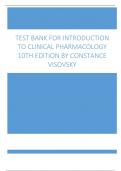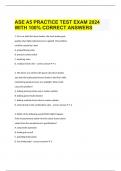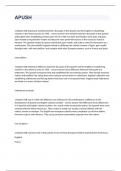TEST BANK FOR INTRODUCTION
TO CLINICAL PHARMACOLOGY
10TH EDITION BY CONSTANCE
VISOVSKY
,Chapter 01: Pharmacology and the Nursing Process in LPN Practice
Visovsky: Introduction to Clinical Pharmacology,
MULTIPLE CHOICE
1. You are assessing the skin of a newly admitted patient and note a 2 inch area of redness at the
sacrum. Which type of data are you collecting with this information?
a. Objective data
b. Inspection
c. Subjective data
d. Alternative therapy
ANS: A
Objective data are obtained by the healthcare provider during physical examination, or that are
measurable (i.e., laboratory results).
DIF: Cognitive Level: Applying REF: p. 3
m
2. Which part of the nursing process includes setting goals for the nursing care required when
er as
giving drugs to a patient?
co
a. Assessment
eH w
b. Planning
o.
c. Evaluation
d. Diagnosis
rs e
ou urc
ANS: B
The nursing process consists of five major steps in this order: assessment, diagnosis, planning,
implementation, evaluation. It is in the planning step that the goals for nursing care related to
o
drugs are set based upon data collected.
aC s
vi y re
DIF: Cognitive Level: Remembering REF: p. 4
3. When would it be appropriate to withhold a drug instead of giving it to a patient?
a. When the order is written by hand
ed d
b. When any part of the drug order is unclear
ar stu
c. When the drug improves the patient’s symptoms
d. When the order contains both the generic and trade name of the drug
ANS: B
is
You must use good judgment in carrying out a drug order. If, in your judgment, the order is
unclear, or incorrect, it should be withheld (not given) until your concerns can be answered by
Th
the patient’s healthcare provider.
DIF: Cognitive Level: Applying REF: p. 4
sh
4. Which action would you take to ensure that an order for a drug is accurate?
a. Check the drug record with the Kardex file.
b. Compare the order with the drug history.
c. Compare the order to the patient’s reason for admission.
d. Check the drug record with the original healthcare provider’s order.
, ANS: D
Once the healthcare provider orders the drug, you must verify that the order is accurate. This
is done by checking the drug chart or drug record with the healthcare provider’s original order.
DIF: Cognitive Level: Remembering REF: p. 4
5. What do the nine “rights” of drug administration include?
a. Right patient, drug, dose, route, time, reason, documentation, response, and right to
refuse
b. Right drug, diagnosis, time, patient, route, drug history, documents, and right to
refuse
c. Right drug, amount, route, time, nurse, reason, route, diagnosis, and documentation
d. Right dose, time, healthcare provider, patient, route, documentation, response, and
drug
ANS: A
There are nine “rights” of drug administration: you must identify the right patient, give the
right drug at the right dose, right route, right time, for the right reason, using the right
documentation to record that the dose has been given, monitor the patient for the right
m
response, and note that the patient has the right to refuse a drug.
er as
co
DIF: Cognitive Level: Remembering REF: p. 5
eH w
6. Which action should you take to ensure that you are giving a drug to the right patient?
o.
rs e
a. Verifying the drug record with the patient name on the chart
b. Verifying the patient’s room and bed number with the chart
ou urc
c. Asking the patient to state his or her birthdate and Social Security number
d. Asking the patient to state their name and birthdate, and then checking the patients
identification bracelet
o
aC s
ANS: D
vi y re
Before giving any drug, two forms of patient identifications should be used to identify the
correct patient. Each patient should be asked his or her name, and another form of
identification, such as birthdate; then you should check the patient’s identification bracelet.
ed d
DIF: Cognitive Level: Applying REF: p. 5
ar stu
7. Which category of drugs should be given exactly on schedule in order to maintain a consistent
level of the drug in the body?
a. Steroids
is
b. Diuretics
Th
c. Aspirin products
d. Anticoagulants
ANS: D
sh
Certain drugs must be given at specific time interval (right time). Anticoagulants must be
given at the same time each day to maintain a therapeutic blood level in order to prevent blood
clots.
DIF: Cognitive Level: Applying REF: p. 7
8. Which nursing action is not appropriate when giving drugs to a patient?
, a. Leaving the drug at the patient’s bedside to take when he/she awakens
b. Asking the patient if he or she has any allergies to drugs
c. Checking a drug reference to verify the action of the drug
d. Explaining to the patient the possible side effects of the drug
ANS: A
It is never permissible to leave drugs at the patient’s bedside. As the nurse, you are responsible
for witnessing the patient taking the drug(s), or documentation of the patient’s refusal.
DIF: Cognitive Level: Applying REF: p. 10
9. Which of the following nursing actions is an example of evaluating patient responses to drug
therapy?
a. Documenting the fact that the patient refused the drug
b. Making sure you have assembled all necessary equipment
c. Taking the patient’s blood pressure before giving an antihypertensive
d. Taking the temperature of a patient an hour after giving an antipyretic
ANS: D
Evaluation is the process of determining the right response of the patient to the drug given.
m
er as
The correct response to an antipyretic is a reduction in fever.
co
eH w
DIF: Cognitive Level: Knowing REF: p. 9
o.
10. Which statement is considered to be an example of objective data gathered in the assessment
rs e
of a patient who will be receiving drugs for the treatment of an injury?
ou urc
a. The patient’s skin is warm and dry to touch.
b. The patient tells you “I have pain in my lower back.”
c. The patient states he is having trouble catching his breath.
o
d. The patient checks off “no history of drug allergies” on the health form.
aC s
ANS: A
vi y re
Objective data are physical findings the nurse can see during careful inspection, palpation,
percussion, and auscultation.
ed d
DIF: Cognitive Level: Knowing REF: p. 3
ar stu
11. You are interviewing a patient to obtain a current drug history. What information should be
part of this report?
a. The color of each drug in pill form
is
b. The names and dosages of each drug
c. The major health conditions of the patient
Th
d. The nursing diagnoses that come from the collected information
ANS: B
In the interview to obtain a current and accurate drug history, the names of each drug and, if
sh
possible, the dosage of each drug are recorded.
DIF: Cognitive Level: Applying REF: p. 3






